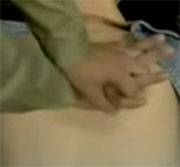
TUESDAY, Oct. 5 (HealthDay News) — Among adults whose heart had stopped beating, those who received ‘hands-only’ cardiopulmonary resuscitation (CPR) from a bystander were 60 percent more likely to survive than those who received no CPR or conventional CPR with mouth-to-mouth breathing.
This is good news, researchers said, because not only is ‘hands-only’ CPR — in which the rescuer does rapid, uninterrupted chest compressions — easier for the public to learn and remember, research shows bystanders are more likely to act when they don’t have to do mouth-to-mouth.
“Anyone can do ‘hands-only’ CPR and anyone can save a life,” contends lead study author Dr. Bentley J. Bobrow, medical director of the Arizona Department of Health Services’ Bureau of Emergency Medical Services and Trauma.
“You don’t have to have a special certification or take a special course,” said Bobrow, who is also an emergency physician at Maricopa Medical Center in Phoenix.
Researchers stressed the findings apply only to adults given CPR by the lay public. Children should still usually receive rescue breathing, Bobrow said, as well as anyone who was choking, drowning or having breathing trouble before becoming unconscious.
The study is published in the Oct. 6 issue of the Journal of the American Medical Association.
In 2005, Bobrow and his colleagues launched a statewide initiative in Arizona to improve rates of cardiac arrest survival, including a performance improvement program for emergency medical services and increasing rates of bystander CPR. With the help of fire departments, the initiative included training throughout the community, in schools, online and a mass media campaign.
From 2005 through 2009, 4,415 adults experienced out-of-hospital cardiac arrest in Arizona and were not treated by a medical professional. Of those, 2,900 received no CPR from witnesses, 666 (about 15 percent) received conventional CPR that includes rescue breathing and 849 (about 19 percent) received compression-only CPR.
About 13.3 percent of those who received compression-only CPR survived and were discharged from the hospital compared to only 7.8 percent of those who received conventional CPR, a 60 percent difference. Those who received no bystander CPR at all fared the worst — only 5.2 percent lived.
Over time, along with public education campaigns encouraging ‘hands-only’ CPR, the annual rate for bystanders attempting CPR improved from about 28 percent in 2005 to nearly 40 percent in 2009. That rise coincided with the shift to the compression-only technique — in 2005, only about 20 percent of lay rescuers did compression-only compared to nearly 76 percent in 2009.
Overall survival increased from about 3.7 percent in 2005 to 9.8 percent in 2009, the study authors reported.
About 300,000 Americans per year experience cardiac arrest, in which the heart stops beating, outside of hospital settings. Without CPR to continue to pump blood and oxygen to the brain, death occurs within minutes, Bobrow said.
Without a bystander to step in and start compressions, emergency responders often arrive too late, Bobrow said. And the longer a victim goes without oxygen, the less likely an automated external defibrillator will work to restart the heart rhythm.
But for a variety of reasons, bystanders often fail to act. Some are unsure what to do, afraid of doing CPR wrong or don’t want to do mouth-to-mouth breathing. “What we have tried to do with ‘hands-only’ CPR is take out all the reasons people don’t act when they see a cardiac emergency — fear, panic, indecision, confusion — out of the equation,” Bobrow said. “There is no reason not to try to do hands-only CPR.”
That’s a crucial message, said Dr. Michael Sayre, an American Heart Association spokesman and associate professor of emergency medicine at Ohio State University. The American Heart Association began recommending ‘hands-only’ CPR in March 2008.
“That Dr. Bobrow and colleagues could increase rates of bystander CPR through a public education campaign and making the instructions simpler is very encouraging,” Sayre said. “In the past, people felt they couldn’t intervene because they hadn’t taken a class or were confused about what to do . . . We’re hopeful that bystander CPR will become more common with simpler instructions. The Arizona study shows this is likely to happen.”
Yet more research needs to be done before it can be said definitively that compression-only CPR works better than CPR with mouth-to-mouth, when done correctly, Sayre said.
Two studies in the July 29 issue of the New England Journal of Medicine also found that when bystanders were instructed by emergency dispatchers to give either standard CPR or chest-compression-only CPR, survival rates were similar between the two techniques.
Why might compression-only CPR work better than conventional CPR for adults?
When doing mouth-to-mouth, the rescuer has to stop compressions, which can lead to a rapid loss of life-sustaining blood flow to the brain, Bobrow said. Also, rescuers may have a tendency to blow too much air into the lungs. Overinflating the lungs can make compressions less effective when they resume, Bobrow said.
More information
Learn more about hands-only CPR from the American Heart Association.

